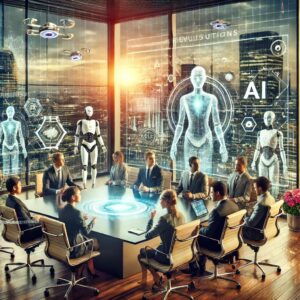Teachers Worry About A.I. for Students. For Themselves, It’s Another Matter
As artificial intelligence (A.I.) continues to evolve, it has started to permeate various facets of education. While many educators are enthusiastic about the potential benefits of A.I. in teaching and learning, there remains a palpable concern regarding its implications for students. This concern is not merely an abstract fear for educators; it is grounded in real, everyday realities that affect teaching methods and student engagement.
The Double-Edged Sword of A.I. in Education
The integration of A.I. into the classroom can be viewed as a double-edged sword. On one hand, teachers recognize the ability of A.I. to personalize learning experiences and provide students with immediate feedback. On the other hand, there are valid concerns about how A.I. might inadvertently undermine traditional teaching methods and student learning.
Advantages of A.I. in Education:
1. Personalized Learning: A.I. can analyze a student’s strengths and weaknesses, tailoring educational content to meet their specific needs. This ensures that students receive the right level of challenge, enhancing their learning experience.
2. Efficiency in Administrative Tasks: Automation of grading and administrative tasks means that teachers can spend more time interacting with students and focusing on their educational needs.
3. 24/7 Access to Resources: A.I. tools can provide students with access to learning materials and assistance outside of traditional school hours, fostering a more independent learning environment.
Concerns Regarding A.I. in Education:
1. Diminished Critical Thinking: Some educators worry that students may become overly reliant on A.I. tools, leading to a decline in their problem-solving and critical-thinking skills.
2. Data Privacy Issues: The use of A.I. often involves the collection of vast amounts of student data, raising important questions about privacy and security.
3. Equity in Access: Not every student has equal access to technology, which can exacerbate existing inequalities in the educational system.
Teachers’ Perspectives on Their Own Use of A.I.
While teachers express significant concerns about the impact of A.I. on their students, their perspectives on using A.I. for their professional development and teaching practices are often more favorable. Many educators are beginning to see A.I. as a tool that can enhance their effectiveness rather than replace them.
Benefits of A.I. for Teachers:
1. Professional Development: A.I. can facilitate personalized professional development opportunities for teachers, aligning training with their specific needs and enhancing their teaching skills.
2. Resource Generation: Many A.I. tools allow teachers to create customized lesson plans and educational materials quickly, saving valuable time.
3. Collaboration Tools: A.I. can enhance collaboration among educators by providing platforms for sharing best practices and resources.
Despite these benefits, teachers remain cautious about the role of A.I. in their professional lives. They fear that over-reliance on technology could devalue their expertise and diminish personal interactions with students.
The Balance Between Technology and Traditional Teaching
The overarching challenge for educators is finding a balance between embracing technological advancements like A.I. while maintaining the essential elements of traditional teaching that foster meaningful relationships and learning experiences.
Key Considerations for Educators:
1. Integrating A.I. Thoughtfully: Educators can adopt A.I. solutions that complement their teaching style rather than completely replace traditional methods.
2. Focus on Critical Thinking Skills: Educators should emphasize critical thinking and problem-solving skills in their curriculum to counteract the potential downsides of A.I. reliance.
3. Continued Professional Dialogue: Ongoing discussions among educators about their experiences with A.I. can help foster a collaborative atmosphere for integrating technology in education effectively.
The Future of A.I. in Education
Looking ahead, the role of A.I. in education is likely to evolve. As schools adapt to the rapidly changing technological landscape, teachers will need to be proactive in shaping how A.I. is used in their classrooms.
Potential Developments in A.I. and Education:
1. Enhanced A.I. Tools: Future A.I. tools may become even more sophisticated, offering deeper insights into student learning patterns and enabling more tailored educational experiences.
2. Regulatory Frameworks: It is crucial for policymakers to establish guidelines that address the ethical concerns surrounding A.I. in education, ensuring that student data is protected and equitable access is prioritized.
3. Professional Development Integration: Schools may increasingly incorporate A.I. training into teacher professional development programs to ensure educators are equipped to use these tools effectively.
Conclusion: Navigating the A.I. Landscape
As A.I. technology continues to advance and permeate the educational landscape, teachers will need to navigate this complex environment with care. The duality of A.I. as both a tool for enhancement and a potential obstacle must be acknowledged and addressed. By focusing on a balanced approach, educators can harness the benefits of A.I. while remaining committed to cultivating the essential human elements of teaching and learning.
In summary, the conversation surrounding A.I. in education is far from over. As both students and educators grapple with its implications, a collaborative effort will be essential to ensure that A.I. serves as a beneficial ally in the pursuit of knowledge and growth. With ongoing dialogue, thoughtful integration, and a commitment to maintaining the integrity of educational practices, the future of A.I. in education can be bright.



